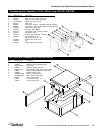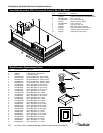
Shelleybasic by Delfield Service & Installation Manual
For customer service, call (800) 733-8829, (800) 733-8821, Fax (989) 773-3210, www.delfield.com
8
Delfield
™
®
Maintenance
Drain Maintenance - Base
Each unit has a drain located inside the unit that removes
the condensation from the evaporator coil and routes it to an
external condensate evaporator pan. Each drain can become
loose or disconnected during normal use. If you notice water
accumulation on the inside of the unit be sure the drain tube
is connected to the evaporator drain pan. If water is collecting
underneath the unit make sure the end of the drain tube is in
the condensate evaporator in the machine compartment. The
leveling of the unit is important as the units are designed to
drain properly when level. Be sure all drain lines are free of
obstructions.
Caster Maintenance
Wipe casters with a damp cloth monthly to prevent corrosion.
The power switch must be turned to OFF and the
unit disconnected from the power source whenever
performing service, maintenance functions or
cleaning.
Stainless Steel Care and Cleaning
To prevent discoloration or rust on stainless steel several
important steps need to be taken. First, we need to understand
the properties of stainless steel. Stainless steel contains 70- 80%
iron, which will rust. It also contains 12-30% chromium, which
forms an invisible passive film over the steel’s surface, which
acts as a shield against corrosion. As long as the protective
layer is intact, the metal is still stainless. If the film is broken or
contaminated, outside elements can begin to breakdown the
steel and begin to form discoloration or rust. Proper cleaning of
stainless steel requires soft cloths or plastic scouring pads.
NEVER USE STEEL PADS, WIRE BRUSHES OR SCRAPERS!
Cleaning solutions need to be alkaline based or non-chloride
cleaners. Any cleaner containing chlorides will damage
the protective film of the stainless steel. Chlorides are also
commonly found in hard water, salts, and household and
industrial cleaners. If cleaners containing chlorides are used be
sure to rinse repeatedly and dry thoroughly. Routine cleaning
of stainless steel can be done with soap and water. Extreme
stains or grease should be cleaned with a non-abrasive cleaner
and plastic scrub pad. Always rub with the grain of the steel.
There are stainless steel cleaners available which can restore
and preserve the finish of the steels protective layer. Early signs
of stainless steel breakdown are small pits and cracks. If this
has begun, clean thoroughly and start to apply stainless steel
cleaners in attempt to restore the passivity of the steel.
Never use an acid based cleaning solution! Many
food products have an acidic content, which
can deteriorate the finish. Be sure to clean the
stainless steel surfaces of ALL food products.
Common items include, tomatoes, peppers and
other vegetables.
Cleaning the Condenser Coil
In order to maintain proper refrigeration performance, the
condenser fins must be cleaned of dust, dirt and grease
regularly. It is recommended that this be done at least every
three months. If conditions are such that the condenser is totally
blocked in three months, the frequency of cleaning should be
increased. Clean the condenser with a vacuum cleaner or stiff
brush. If extremely dirty, a commercially available condenser
cleaner may be required.
Failure to maintain a clean condenser coil can initially cause high
temperatures and excessive run times. Continuous operation
with a dirty or clogged condenser coil can result in compressor
failure. Neglecting the condenser coil cleaning procedures will
void any warranties associated with the compressor and cost to
replace the compressor.
Never use a high-pressure water wash for this
cleaning procedure as water can damage the
electrical components located near or at the
condenser coil.
Units with pans should be operated with pans in
place. Operating the unit without all pans in place
will lower efficiency and may damage the unit.
Defrosting
Refrigerated cold pans and frost tops should be defrosted
daily. Ice Cream counters require defrosting after 3/8 to 1/2 of
frost forming. Frost top ON/OFF switch is located in machine
compartment. Cold pan thermostat has an OFF position.
Never use sharp objects or tools to clean or scrape ice/
frost build up from the refrigerated cold pans or frost tops.
A puncture to the pan could cause irreparable damage to
the refrigeration system.
Over shelves and other items mounted to the top of the counters
should never be installed in the field due to the potential damage
to the refrigeration system.
Plexiglas Food Shield Cleaning
Wet a clean cloth with lukewarm water and dishwashing liquid.
Apply only light pressure, rinse with clear and blot dry with a
damp chamois. For excessively dirty surfaces, rinse surface
dirt off before washing. Fine scratches will disappear when you
polish by hand with a plastic cleaner polish.
Never use window sprays, kitchen scouring
compounds or solvents such as acetone, gasoline,
benzene, alcohol, carbon tetrachloride or lacquer
thinner to clean plexiglas.


















